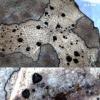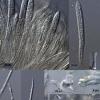
23-11-2025 11:16
Bohan JiaHi, I found small discs growing on dead stem of

21-11-2025 10:56
 Christopher Engelhardt
Christopher Engelhardt
Very small (~0,5 mm) white ascos, found yesterday

21-11-2025 11:52
Jean-Luc RangerBonjour à tous, on voit toujours 2 espèces areni

14-11-2025 16:26
 Marian Jagers
Marian Jagers
Hello everyone, On dead wood of Cytisus scoparius

17-11-2025 21:46
Philippe PELLICIERBonjour,Récolté sur bois pourrissant de feuillu
Coccomyces on Quercus leaves
Garrido-Benavent Isaac,
24-02-2014 18:47
This is a Coccomyces that was growing on dead leaves of Q. ilex subs. rotundifolia and Q. coccifera, in eastern Spain at around 200 m asl.
Following a key shared by B. Declercq here in Ascofrance, I'm not quite sure if my specimens belong to C. dentatus or C. coronatus. Macroscopically, they are more related to the former, microscopically to the later though. Perhaps there are other "intermediate species" which weren't included in that key.
Some of the traits that could help to identify it are:
- Spores 63-87 x 2'5-3'3(4) um, with one rounded end and the other somewhat sharpened, abundant granular content.
- Asci between 95-120 x 9-11 um.
- Paraphyses with more or less clavate tips, straight or slightly curved, surrounded by gel and 3-4 um width.
- Macroscopically, there can be seen 3 to 5 black, irregular teeth. Ascocarp diameter not exceeding 1mm diameter. Hymenium whitish to ivory. Despite I've not studied it yet, there are some black, smaller dots around the ascocarps that could be pycnidia.
Any suggestion will be appreciated!!
Cheers
Isaac



